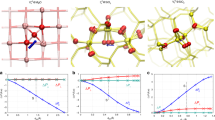Abstract
It is shown that during migration polarization the relaxation time is governed by the carrier lifetime in the bound state, by the thickness of the layer through which the migration occurs, and by the drift velocity. An equation is found for ion migration by generalizing the equation for ion-relaxation polarization. Experimental data found by the Ioffe method on the ion mobility in Al2O3 are reported and compared with the mobilities obtained by the method of this paper, on the basis of the equation for the relaxation time. Migration polarization must be taken into account in analyzing the mechanism for the excess noise and certain cases of current oscillations in semiconductors, dielectric loss of a relaxation nature, relaxation phenomena in film-type active devices, etc.
Similar content being viewed by others
Literature cited
N. P. Bogoroditskii, Yu. M. Volokobinskii, A. A. Vorob'ev, and B. M. Tareev, Theory of Dielectrics [in Russian], Energiya, Moscow-Leningrad (1965).
P. T. Oreshkin, Electrical Conductivity of Refractory Materials and Relaxation Phenomena in Barrier Layers [in Russian], Metallurgiya, Moscow (1965).
A. van der Ziel, Noise, Prentice-Hall, Englewood Cliffs, New Jersey (1954).
R. A. Smith, Semiconductors, Cambridge Univ. Press (1959).
S. N. Levin, Fundamentals of Semiconductor Microelectronics [in Russian], Sov. Radio, Moscow (1966).
P. T. Oreshkin and B. K. Starchenkov, in: Relaxation of the Electrical Conductivity in Dielectrics, Semiconductors, and Microelectronics [inRussian], Ryazan' (1968).
G. I. Skanavi, Physics of Dielectrics (Weak-Field Range) [in Russian], Gostekhizdat, Moscow-Leningrad (1949).
P. T. Oreshkin and L. P. Andreeva, Izv, VUZ, Fiz., No. 1 (1965).
A. F. Ioffe, Physics of Semiconductors [in Russian], Izd. AN SSSR, Moscow-Leningrad (1957).
N. P. Bogoroditskii and V. V. Pasynkov, Materials Used in Radio Electronics [in Russian], Gosenergoizdat, Moscow-Leningrad (1961).
P. T. Oreshkin and B. K. Starchenkov, Izv. VUZ. Fiz., No. 2 (1967).
L. A. Kuznetsova and P. T. Oreshkin, Izv. VUZ. Fiz., No. 2 (1968).
P. T. Oreshkin, B. K. Starchenkov, and L. A. Kuznetsova, Izv. VUZ. Fiz., No. 10 (1968).
B. M. Sokolov and P. T. Oreshkin, Izv. VUZ. Fiz., No. 2 (1969).
Author information
Authors and Affiliations
Additional information
Translated from Izvestiya Vysshikh Uchebnykh Zavedenii Fizika, No. 5, pp. 13–16, May, 1970.
Rights and permissions
About this article
Cite this article
Oreshkin, P.T., Starchenkov, B.K. & Andreeva, L.P. Migration polarization in dielectrics and semiconductors. Soviet Physics Journal 13, 556–558 (1970). https://doi.org/10.1007/BF00823432
Received:
Issue Date:
DOI: https://doi.org/10.1007/BF00823432




